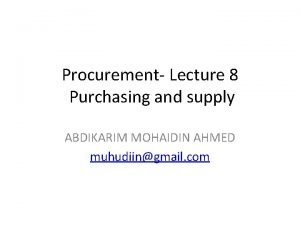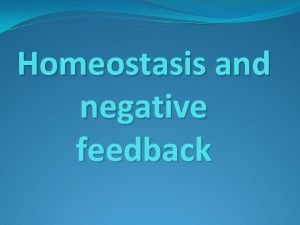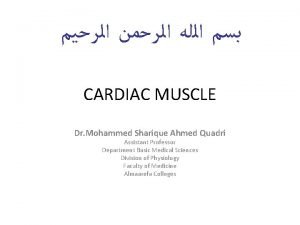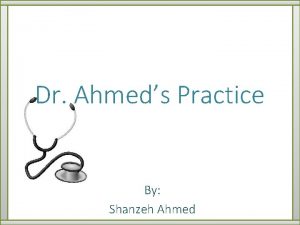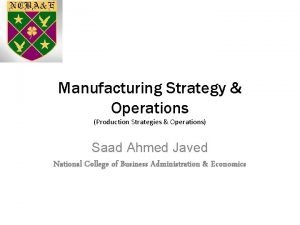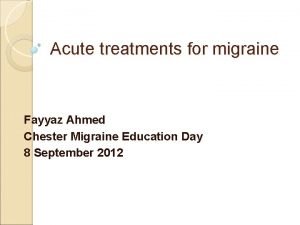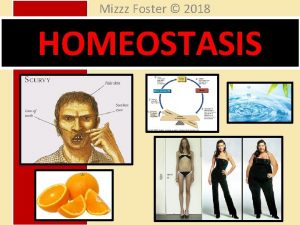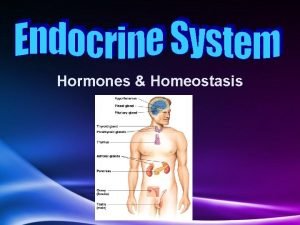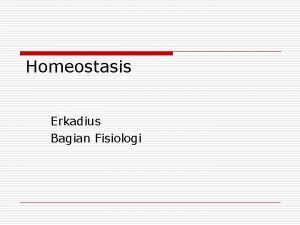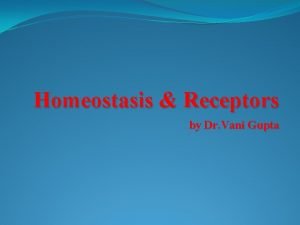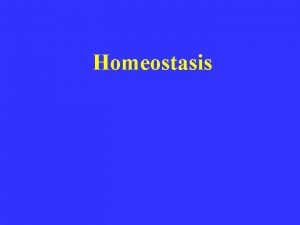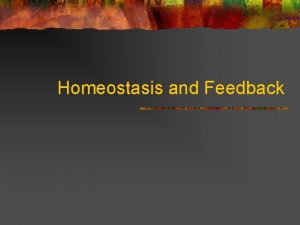24 2 20 GCSE Homeostasis Mrs Shazia Ahmed





































- Slides: 37

24. 2. 20 GCSE: Homeostasis Mrs Shazia Ahmed Microphones – off Cameras – on Don’t chat unless asked to Time will be given for questions!

24. 2. 20 GCSE: Homeostasis Learning Objectives: 1. Define homeostasis 2. Explain how your body stays at the same temperature 3. Know what happens if you get too hot or cold 4. Understand the role of negative feedback loops in homeostasis

A C If you were in these four environments, what would your body be having too much or too little of? D B

Homeostasis Homeo means same Stasis means stable

Homeostasis • Homeostasis: keeping a constant internal environment • What factors are kept the same in your body?

What is Homeostasis? Ø A range of factors need to be maintained Ø Strenuous exercise – like scuba diving and mountain climbing and surviving in hot and cold climates will affect homeostasis: • temperature • blood oxygen levels • hydration • salt levels • Blood sugar levels

What organs are involved in this? Hypothalamus Pituitary gland Lungs Liver Kidney Pancreas



Thermoregulation What does this mean? ?

Dangers of low and high temperature 37°c

Human enzymes work best at 37ºC, so the body’s temperature is controlled. A part of the brain called thermoregulatory centre monitors and controls body temperature. 420 C DEATH from HYPERTHERMIA Dehydration and heat stroke 390 C NORMAL Unusual sweating, fever 370 C 350 C Shivering 330 C Difficulty in staying awake 280 C Breathing stops 250 C DEATH from HYPOTHERMIA

What does your body do if it becomes too warm or too cold?

Keeping a constant temperature. . To keep warm: - Shivering – uses energy - Releasing energy from food - Vasoconstriction - Hairs stand on end To keep cool: -Sweating -Vaso-dilation -Hairs lay flat Controlled by the hypothalamus

Sweating • Produced in sweat glands • Heat transfer to the environment by evaporation of sweat which requires heat, so removing heat from the skin.

Vaso-dilation and vaso-constriction • Amount of blood allowed to flow through blood capillaries near the surface of the skin • Used to cool you down and keep you warm BLOOD VESSELS DO NOT MOVE DURING THIS PROCESS.



Homeostasis “The maintenance of a constant internal environment? ” Input matching output

Negative feedback

Negative feedback is the mechanism by which the body maintains conditions within particular limits. The body will do this by opposing a change that deviates from the normal. The diagram below helps to explain this using the example of body temperature. Too Hot In temperature Sweating, hairs lie flat, and increased blood flow to the skin leads to a ______ in temperature Negative Core temperature _______ ⁰C Shivering, hairs stand on end and decreased blood flow to the skin leads to an ______ in temperature feedback Core temperature _______ ⁰C Too Cold In temperature


Enzymes – lock and key theory Only molecules with the correct shape can fit into the enzyme molecule. This means that enzymes are specific (they will only work on one type of substance)

Sensor Thermostat Heater (switch off) Thermostat Heater (switch on)

Already discussed sweating, how else is the water content in the body controlled?

What are hormones? They are chemical substances that help to regulate processes in the body Hormones are secreted by glands and travel to their target organs in the bloodstream.

What hormone does the pancreas produce? What does this control?

Insulin is a hormone produced by the pancreas that reduces the blood glucose level, ensuring that it remains within narrow limits.

Activity Use the worksheets to put the boxes in order. Draw the pancreas on the cut out body. Write down what would happen if glucose levels became too high or too low.

Too little glucose : causes confusion, unconsciousness, even coma Too much glucose : causes exhaustion and blurred vision

What is diabetes? Diabetes is a disease where the concentration of glucose in the blood is not controlled properly by the body. What are the symptoms? The need to urinate frequently Increased thirst & fluid intake Increased appetite

Processed foods often contain a lot of sugar. This is absorbed easily in the digestive system, causing a rapid increase in the blood glucose level.

Diabetes - 2 forms Type 1 Type 2 Who does it effect? Children and teenagers; adults under the age of 40 Adults, normally over the age of 40; there is a greater risk in those who have poor diets and/or are overweight How does it work? The pancreas does not make enough insulin which leads to high levels of glucose in the blood The body no longer responds to its insulin How is it controlled? Injections of insulin for life and a healthy diet. The extra insulin causes glucose to be taken up by the liver and other tissues. Exercise and appropriate diet with particular care taken over carbohydrates - which are digested into glucose

Why are responses controlled by hormones usually slower than responses controlled by the nervous system? Due to the delay of circulation, hormonal responses are generally slower than nervous response. The nervous system uses rapid electrical signals along nerve axons.

True or False? Type 2 diabetes is a mild form of diabetes People with diabetes cannot have sugar Having diabetes means you can't do certain jobs People with diabetes can't play sport

True or False? Type 2 diabetes is a mild form of diabetes There is no such thing as mild diabetes. All diabetes is serious and, if not properly controlled, can lead to serious complications. People with diabetes cannot have sugar Having diabetes does not mean you have to have a sugar-free diet. People with diabetes should follow a healthy balanced diet – that is low in fat, salt and sugar. You should still be able to enjoy a wide variety of foods, including some with sugar.

People with diabetes can't play sport Having diabetes means you can't do certain jobs Having diabetes should not stop you from getting and keeping a job. However, despite the Disability Discrimination Act (DDA), people with diabetes still face blanket bans in some areas of employment, including the armed forces. Diabetes UK campaigns to lift discriminatory blanket bans. People with diabetes are encouraged to exercise as part of a healthy lifestyle. Keeping active can help reduce the risk of complications associated with diabetes, such as heart disease. Steve Redgrave, Olympic gold medal-winning rower, has achieved great sporting achievements in spite of having diabetes. However, there may be some considerations to take into account before taking up a new exercise regime. Talk to your healthcare team for more information.
 Ahmed muhudiin ahmed
Ahmed muhudiin ahmed What is comparative education
What is comparative education Bioflix activity homeostasis high blood glucose
Bioflix activity homeostasis high blood glucose Bioflix activity homeostasis hormones and homeostasis
Bioflix activity homeostasis hormones and homeostasis Negative feedback gcse
Negative feedback gcse They are mrs garcia and mrs castro
They are mrs garcia and mrs castro Mrs. darling was ___________ of mrs. s.
Mrs. darling was ___________ of mrs. s. They are mrs garcia and mrs castro
They are mrs garcia and mrs castro Anna molka ahmed painting style
Anna molka ahmed painting style Ahmed salemi
Ahmed salemi Ahmed quadri
Ahmed quadri Saad ahmed javed
Saad ahmed javed Shirkat ul amwal
Shirkat ul amwal Fayez ahmed
Fayez ahmed Early life of sir syed ahmed khan
Early life of sir syed ahmed khan Jasmine ahmed
Jasmine ahmed Ahmed kosba
Ahmed kosba Shanzeh ahmed
Shanzeh ahmed Antifungal drugs classification
Antifungal drugs classification Ali ahmed is a mathematics professor who tries to involve
Ali ahmed is a mathematics professor who tries to involve Ahmed miree
Ahmed miree Dr mohammed ahmed
Dr mohammed ahmed Manufacturing strategies
Manufacturing strategies Iti 1100
Iti 1100 Examples of inductive method
Examples of inductive method Stomodeum
Stomodeum Ahmed zarouf
Ahmed zarouf Dr ahmed hashim
Dr ahmed hashim Marina ahmed
Marina ahmed Hezarfen çelebi mesleki ve teknik anadolu lisesi
Hezarfen çelebi mesleki ve teknik anadolu lisesi T tubules
T tubules Amina ahmed md
Amina ahmed md Prevention of scabies ppt
Prevention of scabies ppt Musul salyaneli mi salyanesiz mi
Musul salyaneli mi salyanesiz mi Ahmed chester
Ahmed chester Ahmed mustapha
Ahmed mustapha Ahmed bououd
Ahmed bououd Ifte ahmed
Ifte ahmed
